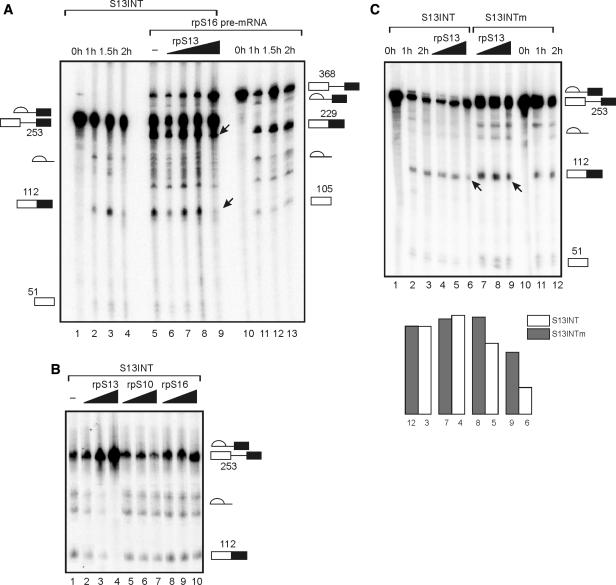Figure 4.
rpS13 specifically inhibits in vitro splicing of the S13INT transcript. (A) Effect of rpS13 on splicing of S13INT and rpS16 pre-mRNA fragment. Products of splicing were separated on 6% denaturing PAAG. Time course reactions of the transcripts alone (lanes 1–4 and 10–13) and 2 h incubation under splicing conditions of the transcripts taken together in the presence of rpS13 at concentrations of 0.3 μM (lane 6), 1 μM (lane 7), 3 μM (lane 8), 8 μM (lane 9) or without the protein (lane 5). Positions of RNAs on the gel and their lengths are denoted on left (for S13INT) and on right (for rpS16 pre-mRNA). Arrows on the gel (lane 9) indicate presence of the mRNA product for rpS16 pre-mRNA splicing and its absence for S13INT. (B) Effect of rpS13, rpS16 and rpS10 on the S13INT splicing. Products of S13INT splicing after 2 h incubation under splicing conditions in the presence of rpS13 (lanes 2–4), rpS10 (lanes 5–7) and rpS16 (lanes 8–10) at concentrations of 1 μM (lanes 2, 5, 8), 5 μM (lanes 3, 6, 9), 8 μM (lanes 4, 7, 10) or without protein (lane 1), separated on 6% denaturing gel. The positions of the RNAs are indicated on right. (C) Comparison of effects of rpS13 on the in vitro splicing of S13INT transcript and of the transcript mutated in the vicinity of both the 5′ and 3′ splice sites (S13INTm). Lanes 1–3 and 10–12—time-course reactions. Splicing products after 2 h incubation of S13INT (lanes 4–6) and S13INTm (lanes 7–9) under splicing conditions at the presence of rpS13 at the concentration 1 μM (lanes 4 and 7), 3 μM (lanes 5 and 8), 6 μM (lanes 6 and 9). Arrows indicate presence of the mRNA product with S13INTm (lane 9) and its absence with S13INT (lane 6). The diagram below represents quantification of the gel data. Each column represents the ratio of the intensities of bands for the mRNA product and the pre-mRNA on the respective lane on the gel in arbitrary units. The height of column is proportional to the splicing efficiency. White columns are for S13INT, grey ones are for S13INTm. Columns are grouped in pairs for splicing reactions carried out under the same conditions.

